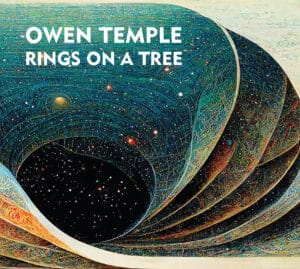The Collection Investigates His Family History and The History of Humankind with His Usual Blend of Humor and Honesty
Owen Temple’s new record, Rings on A Tree, is a concept album – an examination of family history and the way every interaction we have reverberates for generations.
“It’s clear that our lives are a distillation and expansion of the lives that have come before us,” Temple said. “Every life, every interaction of matter and energy that happens, reverberates through the universe in an ever-expanding field. Waves of behavior that cause other waves of behavior, not just in one life, but in all our lives. These songs didn’t get written because of Covid, but the lockdown gave me the opportunity to spend time with my family and consider where we came from and where we may be going.
“I didn’t get sick, but everybody else did – my wife and kids. I had a kindergartener doing classes on Zoom and, with everybody home, life was full. “During the Covid lockdown, I wasn’t writing much on my own, but when a friend – most frequently Walt Wilkins – would call and say, ‘Let’s go to a park and write a song,’ I’d always go. We’d sit in the shade of a tree, making up songs in the midst of the fear and uncertainty. These meetups resulted in a reexamination of what’s important in life. We wrote songs that looked at the intergenerational interactions that created a certain wisdom, insights that transcend our narrow view of the present.”
Rings On a Tree opened up the creative process for Temple, without any reservations or expectations. “It was fun to sit down with someone and venture into the chaos of our own imaginations, trying to put things together, finding patterns that resonated for both of us. Writing a song is a way of having a deep interaction. It avoids the – ‘I’m fine!’ – of normal, superficial conversations. We aimed at catching the deeper currents and real challenges in our lives.
As the songs accumulated, Temple saw them taking a spiritual, philosophical tone. “I was haunted by the ideas of our great-grandparents. Shadowy photos and mysterious documents from their eight lives give us clues about how these people have major consequence on our lives, even if we don’t understand exactly how. Through the process of writing the songs, I developed a personal mythology. I began wondering what I’m doing with this life they’ve given me. Music allowed me to emotionally connect with them.
“Genealogy is just dates, like dry leaves, but they can be woven into songs that express gratitude for the way their lives influence the present. With my co-writers, I grabbed onto the stories of the past that resonated for us and brought them into the present. If you trace the branches of any family tree back far enough, you can see we’re all connected. That inspired the song ‘Rings on a Tree’ and the entire album.”

AN ALBUM IN THREE PARTS – BIG BANG, PANTHEON, AND TREE OF LIFE
Temple organized the songs into three five song sets: Big Bang, Pantheon and Tree of Life. “The tree is an important symbol,” he said “Looking at the rings in a tree is like looking at a spiral galaxy or a snail shell, circles within circles, the patterns that are all around us, reflecting how interconnected and intertwined human beings are.
““Part 1 – Big Bang is about beginnings, investigating the consciousness we all share. Before any stories are made, there is I AM, my ancestors and yours, the beginning of knowledge, the awareness of being a finite, mortal human. The perspectives on ‘Days,’ ‘Watch It Shine,’ and ‘Beautiful Accidents’ are all perspectives of squinting to see where we first appear on the historical map of space and time. ‘Always Becoming’ acknowledges the forward motion and the constants of change, growth, and evolution.
“Part 2 – Pantheon contains songs about connecting with our human ancestors and our lineage. ‘Fork in the Road’ is about the path not taken and the continual choice of our next steps. ‘Can’t Stop Won’t Stop’ and ‘Virginia and Hazel’ are songs about great-grandparents and the concerns and experiences they had when they were young people that then had consequences for us, their descendants, in our lifetimes. My co-writer, Kelly Mickwee and I, tried to use their voices and the slang they used in the 1920s. ‘Are We There Yet’ is about the intergenerational car trips in all of our lives – the older people in front and the younger people in the back wondering where we’re going. ‘Churches and Cantinas’ is anthropological, studying the impulse toward redemption that those two institutions (represented by two people in the story) seek each in their own way.
“Part 3 – Tree of Life presents the connection to nature that is the core of our lineage. ‘Wild Seeds’ and ‘Rings on a Tree’ are about the struggle to survive and thrive that we share in common with all life; ‘Gentle James’ is about an ancestor who was a farmer and the people he influenced, despite being a shy man, uncomfortable with others. ‘More Like September’ is a love song both to fall and to a love that abides between extremes. ‘Twenty Years’ ties everything up with a fantasy of meeting with your future self to receive some spiritual guidance.”
RECORDING AT THE FINISHING SCHOOL
Temple enlisted the help of producer Gordy Quist to bring the songs to life. “Gordy’s been a songwriting collaborator for a long time. He took over The Finishing School, the revered studio of George Reiff (Band of Heathens, Ray Wylie Hubbard). I love his sonic aesthetic. We took the time to pause, after we played it through for the musicians in the studio, and ask, ‘Is there anything we can do to make it more interesting?’ He approached the arranging in a way that was both comfortable and challenging.”
Temple and Quist played guitar and Temple’s long time rhythm section – Josh Flowers on bass and drummer Rick Richards – laid down the foundation. Other players included Trevor Nealon from Band of Heathens on organ and piano, Geoff Queen on pedal steel, Dobro and guitar and invited guests adding vocal harmonies and fiddle. “Everyone came up with little melodic hooks, easily and effortlessly,” Temple said. “Some tunes were played more sparsely, like country or bluegrass; some had a full rock’n’roll feel, but roots music is my home. Everyone played in a timeless, tasteful manner.”
The album opens with “The Song of Us,” a mid-tempo country tune, celebrating a world that’s changing fast, but fundamentally stays the same. Baritone guitar and pedal steel bubble beneath Temple’s vocal, as he delivers a mellow benediction uniting earth and the cosmos through the breath of a single human. “If Thich Naht Hahn and Frank Sinatra wrote a song together, would it sound like this?”
Long sustained notes from Geoff Queen’s pedal steel gives “Watch It Shine” a celestial aura. Temple celebrates the light within and the light that surrounds us – the shimmering of the sun, moon and stars. They’re all reflected in the harmonies of the chorus. “Beautiful Accidents” describes the magical moments in life that are often overlooked until years later. Temple and Kelley Mickwee (the song’s co-writer) sketch out a family’s history, from first kiss to marriage, jobs, and family. Acoustic mandolin and Nealon’s smooth electric piano give the music a nostalgic ambience.
“Fork in the Road” is an up-tempo rocker, with a hint of R&B in its swirling organ, crunchy electric guitar and cool backbeat. The uplifting harmonies of the chorus remind us that every moment changes our lives in profound, if unrecognized ways. “Are We There Yet?” is a bluesy country tune with twanging guitars, sticks on the snare and piano keys clicking like highway mile markers on a long summer road trip. The chorus suggests a ‘50s rock’n’roll hit playing on a radio.
The music on the album flows smoothly, highlighting the journeys of individuals, families and humanity as a whole, on the meandering track of history.. “It’s the arc of a hero’s journey that Joseph Campbell identified,” Temple said. “The idea of venturing out of your ordered life to have experiences that will change you for the better. I write songs using wisdom as fuel. The intended outcome for myself, and the listener, is understanding, connection and communication, a recognition of the beauty and mystery of our earthly experience. The songs are artifacts from the paths we’ve walked, as individuals and part of humanity. The hope is they’ll forge a connection to the past that will help us make wiser choices in the present.”
READ THE LINER NOTES AND LYRICS (10 MB)










